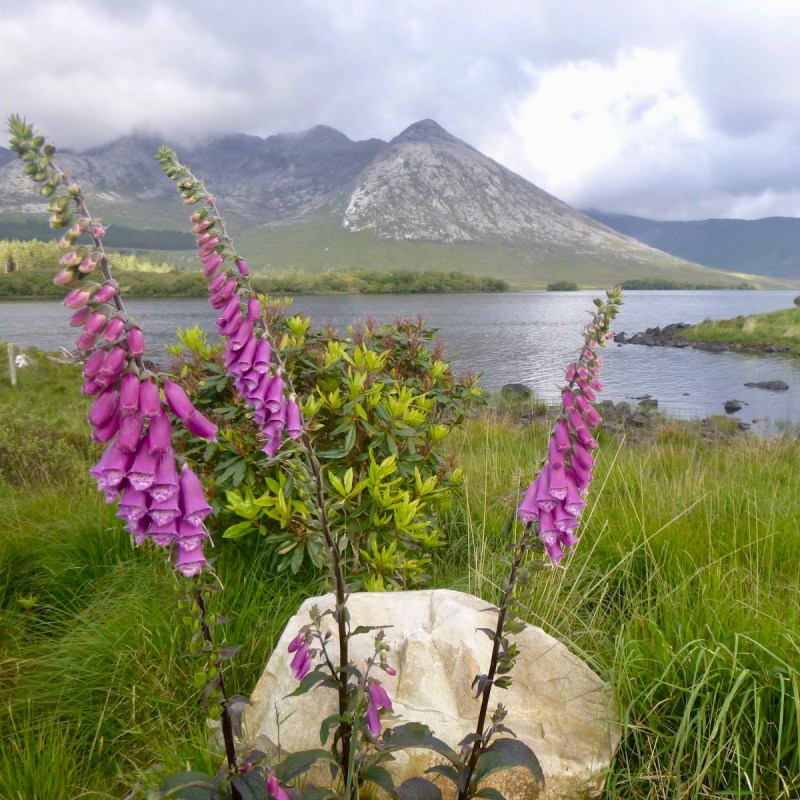
“Enchanting” is a fanciful term that sounds like hyperbole. More fairytale than reality. But that’s exactly how I would describe the Connemara region of Ireland. Enchanting. Surreal. Storybook.
Videos by TravelAwaits
Once upon a time, a couple traveled to Connemara…
My husband Dean and I have taken several biking trips with bike vacation company VBT, like to Acadia National Park in Maine and Slovenia/Austria/Italy (and even the emotional tug that came with that last one). We’re onto them — we know they run a first-rate trip. We know their guides are stellar. And we know they always seem to plan their itineraries with an impressive conclusion.

And so it was that Dean and I signed up for VBT’s Ireland: Galway & Connemara Coast with great expectation. After we biked in Lisdoonvarna, the Burren, Galway, and the Aran Islands, we headed northwest from Galway into what I’ll call the pinnacle of the trip: the lovely Connemara region.
I loved this enchanting region. Here are some reasons why.

1. The Wild Atlantic Way
It’s thrilling to bike along The Wild Atlantic Way (WAW), the longest coastal route in the world. It covers some 1,600 miles along Ireland’s dramatic western coastline from the northern Inishowen Peninsula to the southern town of Kinsale in County Cork. The wild Atlantic Way is aptly named for the ocean’s rugged storms that have been transforming Ireland’s western coast for centuries.
As we biked, we noticed the blue zigzag pattern on road signs, indicating the WAW. It wasn’t such a leap to see how the initials fit this pattern. We also learned that biking the sometimes-gritty WAW offers a sort of free facial exfoliating. What service!
Pro Tip: Biking the WAW is not for the faint of heart. While I never felt like it was dangerous, there are no wide shoulders here, no bike lanes. Just narrow, curving roads.
2. The Twelve Bens
The Twelve Bens are a mountain range in central and northern Connemara and are part of Connemara National Park. They parallel another mountain range, the Maumturks, and together, their quartzite summits and ridges create an impressive 360-degree view. Many of the mountain summits are more than 2,000 feet high. I loved biking here.

3. Free-Range Sheep
In Connemara, it isn’t unusual to see sheep on both sides of the road. Sometimes, a car or two would be thrown into the mix. While cars and bikers adjusted, the sheep typically seemed oblivious to the whole scene. An Irish traffic jam!
Pro Tip: Unlike the U.S., the Irish drive on the left side of the road. Since bikers follow vehicle traffic direction, it’s another reason to stay alert when biking there.

4. Turf Stacks
As we biked, we saw a curious sight. Later, we learned that Irish people used to use peat turf to heat their homes and cook food. It was a laborious process because they cut the blocks by hand.
In Connemara, the tradition of using turf as fuel lives on, but now, machines do the cutting. We passed long trenches where chunks of turf had been harvested, and other areas with turf stacks — blocks stacked against each other — standing upright to dry in the sun and wind.

5. Lough Inagh
I will never forget my first glimpse of Lough (Lake) Inagh. Clouds covered the mountaintops, the lake loomed larger than life to our left, and far in the distance, our hotel. Our VBT guide told us we wouldn’t be able to miss it, and he was right. Photos don’t do it justice. As I biked into this scene, I felt like I had biked right into a storybook.

6. The Lough Inagh Lodge
In the heart of the Twelve Bens and the Maumturk Mountains, on the shores of Lough Inagh, sits the picturesque Lough Inagh Lodge. Not surprisingly, it looks just like an 1800s Irish lodge should look. We had a gorgeous corner suite with a four-poster bed, two separate sitting areas, and windows in three directions. As a bonus, the first time I looked out one of these windows, I saw a friendly neighborhood sheep grazing on the lodge’s front lawn.

To get down to the lake from the lodge, we walked through this amazing gate. What’s a storybook if you don’t have a magical gate to walk through? Ideally, it will lead to a meadow, a lake, and mountains. Check, check, and check.
Pro Tip: The Lough Inagh Lodge is rural Connemara at its best. You won’t find nightlife and activities around here, but they have the wonderful Finnisglen Restaurant and a wooden bar, full of character and, likely, full of characters.

8. Foxglove Flowers
When we got to the lake, we saw patches of foxgloves with their deep pink blooms and speckled centers. They grow wild in Connemara and added to the charm of the area.

9. Kylemore Abbey
Founded in 1920, Kylemore Abbey is a Benedictine monastery (the oldest in Ireland) in Connemara. The abbey was founded for Benedictine nuns who fled Belgium in World War I. We did a self-tour here. How often can you tour a lakeside-castle-turned-monastery?

The Abbey has beautiful architecture and furnishings. A striking feature was an overhead spotlight with a filter that imprinted PAX (which means “peace” in Latin) on the floor, surrounded by other important Benedictine words: Hospitality, Work, Welcome, Community, Simplicity, Listen, Contemplation, Prayer, Love. If I stood in this spot, the words would shine on me.

10. Kylemore’s Neo-Gothic Church
After touring the Abbey, we walked 5 minutes to another remarkable building on the property. In the 1860s when Mitchell Henry (owner of Kylemore Abbey at that time) tragically lost his wife to a sudden illness, he commissioned a neo-Gothic church in her memory.
Since it was a memorial, we saw sculpted angels on the building where gargoyles might typically have been. Inside, light Caen sandstone added a natural peaceful element, and colored marble pillars showcased four regions in Ireland: green from Connemara, rose from Cork, black from Kilkenny, and gray/white from Armagh/Tyrone.

11. Kylemore Abbey’s Victorian Walled Garden
A short shuttle ride took us to Kylemore Abbey’s famous Victorian walled garden. It was one of the last walled gardens built during the Victorian period in Ireland (late 1800s) and has been compared with the Kew Gardens of London. The 6-acre grounds are divided in half by a mountain stream and include flower and vegetable gardens, fruit trees, an herb garden, and more.
I’m not sure if this is a standard feature, but as we were leaving the gardens, we came upon a pen with two pot-bellied pigs!
Pro Tip: Tickets are sold online to the Kylemore Abbey and grounds.

12. Renvyle Peninsula
The Renvyle Peninsula is known for serenity and tranquility. We passed babbling brooks, lakes, and more mountains and sheep. As I understand it, the coloring we saw painted on sheep was connected to ownership, shearing schedule, or breeding. The biking here was hilly but so rewarding.
Pro Tip: Hungry? Try traditional Irish scones with fresh butter, homemade raspberry jam, and clotted cream at the Renvyle House Hotel and Resort.
13. Irish Coffee
One night after dinner, our biking group of 16 people (age 16 to 70-something) gathered in one of the old libraries, and the Lodge bartender — a man full of personality and quick wit — showed us how to make the perfect Irish coffee. He explained and demonstrated the step-by-step process, and then invited us to make one for ourselves. I wrote about the process here.
Pro Tip: If Irish coffee is not your thing, there’s always Guinness or the almost equally popular Smithwick’s beer. Say it like a local: the “w” is silent (Smith-icks).

Ah, Connemara. Referred to as a “savage beauty” by Irish writer Oscar Wilde, I’d rather just call it “storybook.” Our VBT guide, native to Ireland, said Connemara is his favorite part of the biking trip. It’s easy to see why.
When you go, you’ll have to decide if Connemara fits Wilde’s descriptor or ours. As for Dean and me, you can say we stuck with “storybook”… and lived happily ever after.
Related Articles:
